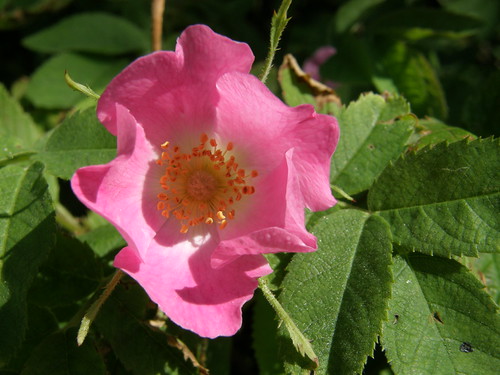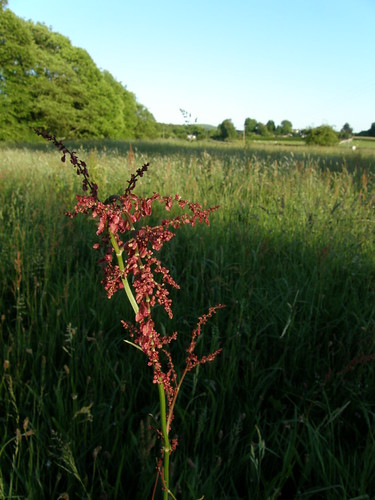Yesterday was Silverdale Field Day – a kind of Carnival with races; fancy dress, Morecambe Brass Band, a parade, bunting, stalls, bouncy castles, ice-cream, hot-dogs, egg-and-spoon, cream teas and a Fell Race. Naturally, somebody has to erect the marquees, hang up the bunting, make the scones and cakes for the cake stall etc etc. Since TBH and I are two of those people, the last couple of days have been rather busy. (Though for others, who deserve a medal at the very least, the last week has been completely hectic)
We rounded off the day, after the tidying up was almost done, with an (almost) impromptu barbecue, football match and rounders at the Institute Field where the whole day had been centred. The day stayed fine, despite early drizzle and occasional threatening spots of rain, and everybody had a good time I think. So well worth it then.
The in-laws were over to help with child-minding whilst I was helping to erect the marquees, hang up the bunting, marshal the fell race etc, so today TBH and I were able to have a day off on our own in the Lakes.
We weren’t particularly early, but managed to find a spot to park just outside the village of Elterwater. I’d warned TBH that the path between Elterwater and Skelwith Bridge would be boggy in places, but my information was clearly well out of date because the whole path has now been surfaced and, as TBH pointed out, would be suitable for a push-chair. It was very busy.
The path follows Langdale Beck and then passes beside Elterwater (the lake rather than the village) without affording many views of it, but there is a good view from the far end of the lake…

…looking up Langdale to the Pikes.
TBH pointed out this stump in the stream. The buttercups growing on it were catching the sun and setting-off the greenery all around beautifully. Sadly, my camera seems to have been immune to the charms of that prominent yellowness…

I think of this walk as a favourite, but it’s obviously a neglected favourite since I’ve never shared it before with TBH and this bridge has appeared since I last came this way…

…we crossed over to try out the path on the other side – which was very pleasant, but meant that I didn’t get a good chance to photograph Skelwith Force, a small but powerful waterfall just below the bridge.
We lunched at Chester’s, (I’ve added the apostrophe in the spirit of grumpy old mandom). This was a long planned visit which has taken a while to come to fruition. I’m glad that we stuck with the idea, my Caesar salad was excellent. (I’ll leave the restaurant criticism to Ken though). I had most sections of yesterday’s Guardian in my rucksack, and after our meal we transferred to a sofa for tea and a quiet afternoon read – readers with children will appreciate the sheer luxury of this experience.
The sofa wasn’t as comfortable as it looked so we were soon walking again. Crossing back over…well the River Brathay, it’s not Langdale Beck here and may not have been further upstream – I’m not sure where the transition takes place. Anyway, crossing the road bridge I enjoyed the pattern of leaves and flowers on a rocky mid-stream island…

Our onward route, which was altogether quieter, took us through a patchwork of flower-rich meadows and woods. Foxgloves were ubiquitous in both…

We passed by Colwith Force – much bigger and more impressive then Skelwith Force but a little further from a road and so a much quieter spot…

…we shared it with two other walkers who had scrambled down the steep riverbank to take photographs without the intervening screen of trees – you can see that I let discretion be the better part of valour in this case.
We were heading towards Little Langdale, with every view foregrounded by buttercup meadows…

There are several options for completing the route from here, but we turned right at Stang End, where I liked the handsome split-level barn and TBH admired the neat woodpiles…

…and headed down to the stream in the valley bottom. The meadows in fact held much more than buttercups. In the boggy ground near to the stream I was particularly pleased to find this Eyebright…

In fact after seeing these first few flowers I noticed that it was widespread as we climbed out of the valley too. Apparently it’s a semi-parasite, the roots attaching themselves to another plant such as Clover or Plantain. The name refers to the fact that Eyebright has been used to treat eye-ailments. There are apparently 25 species of Eyebright growing in the UK, but I assume that this is Common Eyebright, Euphrasia Nemorosa. Euphrasia from the Greek word Euphraino meaning ‘to gladden’.

Is it working?
There were also quite a few Yellow Rattle, which I’ve mentioned a fair bit recently.

It doesn’t show up well here against the much brighter buttercups, but it probably has the last laugh, because it is a hemi-parasite (the difference between hemi and semi is…?) which attaches itself to the roots of other plants and then leeches water and minerals from them.

The name Rattle refers to the noise made by the seeds inside their capsule. The ‘official’ name is Rhinanthus Minor, Rhinanthus from the two Greek words for ‘nose’ and ‘flower’ referring to the hooked tube at the top of the blooms, and Minor because there is a larger, but much rarer species Greater Yellow Rattle.
A helpful National Trust sign at the entrance to Tongue Intake Plantation had told us that we might find Lungworts growing on the trees hereabouts. We didn’t. Gives us a great excuse to go back and have another look though…





















































































